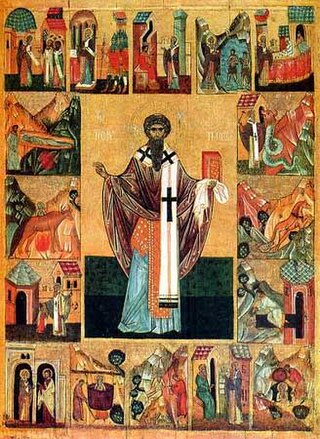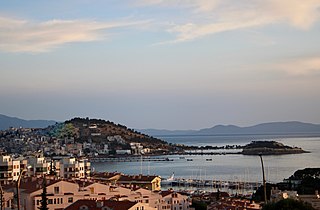Related Research Articles

Ephesus was a city in Ancient Greece on the coast of Ionia, 3 kilometres (1.9 mi) southwest of present-day Selçuk in İzmir Province, Turkey. It was built in the 10th century BC on the site of Apasa, the former Arzawan capital, by Attic and Ionian Greek colonists. During the Classical Greek era, it was one of twelve cities that were members of the Ionian League. The city came under the control of the Roman Republic in 129 BC.

Pseudo-Dionysius the Areopagite was a Greek author, Christian theologian and Neoplatonic philosopher of the late 5th to early 6th century, who wrote a set of works known as the Corpus Areopagiticum or Corpus Dionysiacum.

The Council of Ephesus was a council of Christian bishops convened in Ephesus in AD 431 by the Roman Emperor Theodosius II. This third ecumenical council, an effort to attain consensus in the church through an assembly representing all of Christendom, confirmed the original Nicene Creed, and condemned the teachings of Nestorius, Patriarch of Constantinople, who held that the Virgin Mary may be called the Christotokos, "Christ-bearer" but not the Theotokos, "God-bearer". It met in June and July 431 at the Church of Mary in Ephesus in Anatolia.
In Greek mythology, Otrera was the founder and first Queen of the Amazons; the consort of Ares and mother of Hippolyta and Penthesilea. She is credited with being the founder of the shrine of Artemis in Ephesus.

The Comedy of Errors is one of William Shakespeare's early plays. It is his shortest and one of his most farcical comedies, with a major part of the humour coming from slapstick and mistaken identity, in addition to puns and word play. It has been adapted for opera, stage, screen and musical theatre numerous times worldwide. In the centuries following its premiere, the play's title has entered the popular English lexicon as an idiom for "an event or series of events made ridiculous by the number of errors that were made throughout".

Selçuk is a municipality and district of İzmir Province, Turkey. Its area is 317 km2, and its population is 38,151 (2022). The town Selçuk is located 2 kilometres northeast of the ancient city of Ephesus, that was once home to the Temple of Artemis, one of the Seven Wonders of the Ancient World.
Flavius Hypatius was a Eastern Roman noble of imperial descent who held the position of commander in the East during the reign of Justin I, and was chosen by the mob as emperor during the Nika riots in Constantinople against Justinian I and executed shortly thereafter.

A xoanon was a wooden cult image of Archaic Greece. Classical Greeks associated such cult objects, whether aniconic or effigy, with the legendary Daedalus. Many such cult images were preserved into historical times, though none are known to have survived to the modern day, except as copies in stone or marble. In the 2nd century CE, Pausanias described numerous xoana in his Description of Greece, notably the image of Hera in her temple at Samos. "The statue of the Samian Hera, as Aethilos [sic] says, was a wooden beam at first, but afterwards, when Prokles was ruler, it was humanized in form". In Pausanias' travels he never mentions seeing a xoanon of a "mortal man".
Saints Leontius, Hypatius and Theodolus were Roman soldiers who, according to Christian tradition, were martyred for their faith.

Hypatius of Gangra was Titular Bishop of Gangra, Asia Minor. He was present at the First Ecumenical Council where he supported Saint Athanasius the Great against the Arian heresy. The Eastern Orthodox Church celebrates him on March 31 and Roman Catholic Church celebrates him on 14 November.
Flavius Probus was a politician of the Eastern Roman Empire and relative of the Emperor Anastasius I.

Flavius Patricius was a prominent Eastern Roman general and statesman during the reign of Byzantine emperor Anastasius I.

The Temple of Artemis or Artemision, also known as the Temple of Diana, was a Greek temple dedicated to an ancient, local form of the goddess Artemis. It was located in Ephesus. By 401 AD it had been ruined or destroyed. Only foundations and fragments of the last temple remain at the site.
Hypatius may refer to:
Pompeius was a politician of the Eastern Roman Empire and nephew of the Emperor Anastasius I. His family gained political prominence with the accession of Anastasius. Pompeius was consul in 501, and was elevated to the patricianate, probably by Anastasius. He held military office, serving in the Iberian War. He married a woman named Anastasia, and had at least one son. In 532, Pompeius' brother Hypatius was acclaimed emperor by the rioters during the Nika riots; after the riots were put down, both Hypatius and Pompeius were executed.

Hypatius Pociej, Polish: Hipacy Pociej, Ukrainian: Іпатій Потій) was the "Metropolitan of Kiev, Galicia and all Ruthenia" in the Ruthenian Uniate Church — a sui juris Eastern Catholic Church in full communion with the Holy See. He reigned from 1599 to his death in 1613. He played an active role in the 1595 Union of Brest of which he was a firm supporter. He was also a writer, polemist and theologian.
Flavius Hypatius was a Roman Senator, who was the brother-in-law of the Roman emperor Constantius II.
The Metropolis of Ephesus was an ecclesiastical territory (metropolis) of the Ecumenical Patriarchate of Constantinople in western Asia Minor, modern Turkey. Christianity was introduced already in the city of Ephesus in the 1st century AD by Paul the Apostle. The local Christian community comprised one of the seven churches of Asia mentioned at the Book of Revelation, written by John the Apostle. The metropolis remained active until 1922-1923.

Marathesium or Marathesion was a polis of ancient Ionia on the coast south of Ephesus, which was a member of the Ionian League. Marathesium was too small to be a member of the League or even to stand independently on its own. It has been classified recently as a dependent polis of one of the members of the League, first of Melia, then of Miletus after Melia had been defeated in the Meliac War, then of Samos, by lawsuit based on its occupation, and finally of Ephesus by a treaty involving the swap of cities.
References
- ↑ Alexander, Paul J. (1952). "Hypatius of Ephesus: A Note on Image Worship in the Sixth Century". Harvard Theological Review . 45 (3): 177–184. doi:10.1017/S0017816000020824. S2CID 162906172.
- ↑ Copleston, Frederick (1985). A History of Philosophy, vol. 2. Image Books. p. 91.